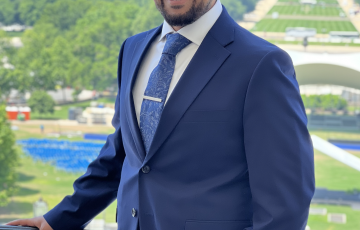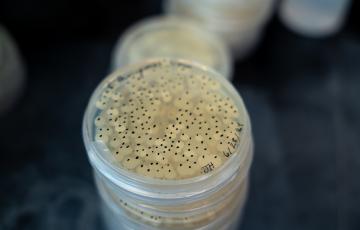UMCES chemist Michael Gonsior discusses our ‘Plastic Ocean’ at IMET
Baltimore, MD (September 7, 2017)
Michael Gonsior, a chemist at the University of Maryland Center for Environmental Science’s Chesapeake Biological Laboratory, joined a research team for a 2009 excursion into the Pacific Ocean to study the extent that plastics had entered our waters. The trip was featured in the documentary film, “A Plastic Ocean.” (Read more about his trip here: http://www.umces.edu/news/umces-michael-gonsior-sees-scope-plastic-pollution-pacific-ocean-cruise) The Institute of Marine and Environmental Technology hosted an abridged screening of the film and invited Gonsior to host a question-and-answer session with the audience. Below are some of the questions Gonsior answered. A portion of this piece has been edited for clarity.
Audience: What do you think is the source of most of the plastic debris in the ocean?
Michael Gonsior: The biggest sources, by far, are the rivers and streams going right to the ocean. If you look at the L.A. river, there are a huge amount of plastics there, but we don’t have to go very far. Look at Baltimore Harbor with runoff. If you have a big rain event, everything is flushed into it and that flushes directly into the ocean.
Audience: Primarily that would be litter, correct?
Gonsior: Yes, but there’s also other sources. We found a lot of these pre-production pellets and that’s from containers getting lost. There are hundreds of thousands of little pieces floating along. And also spills, we’ve seen spills from train transporting.
Audience: Did you start in 2009 with the idea of looking at plastics?
Gonsior: Who started the whole movement was Capt. Charles Moore. He started with the Algalita (Marine Research) Foundation out of California and it’s been almost 20 years since he went for the first time to the North Pacific Gyre and saw the accumulation of plastics. I interacted with him and I got to know a few more people. Then I was invited on that privately funded research excursion going out into the Pacific from San Francisco, which really geared up in 2009.
Audience: Have you used legislation and policy to impact this issue of microplastics?
Gonsior: In terms of how microplastics get into the waterway, we didn’t know that before, but there is now some legislation going into place banning adding microplastics to cosmetic products—that’s going to be phased out. That’s very good news. In terms of plastic that gets into the ocean and breaks up, that’s an entirely different issue. Really it comes back to preventing it from getting there in the first place. That’s the bigger issue. Microplastics come from bigger plastics. There are efforts in place where we can do this (i.e. plastic bag bans), because it’s such an obvious problem, but it wasn’t obvious even 10 years ago.
Audience: What would your advice be for someone who really cares to convince other people to care?
Gonsior: Our part is not pointing fingers and saying, ‘Why don’t you do anything?’ I think that’s the wrong way, but perhaps sneaking something in like, ‘Hey, I’m going to watch a movie, you want to see it?’ It’s always attached with a lot of emotions. Emotions drive us; we’re emotional beings. I think the way to go is to not be angry about it, but rather trying to encourage them: ‘Hey, I’ve heard there’s something interesting going on. It’s environmental, but you’re probably interested for other reasons, so maybe we can watch it together’—without strings attached. It’s hard; it’s not an easy task, by any means, but the direct approach is not working. A lot of people live in their bubbles and don’t really want to break their bubble.
Audience: How can we be assured that what we’re putting in the recycling is actually being recycled?
Gonsior: I’ve heard that a lot. I would argue the effort of putting it in the actual recycling bin, that is the only chance to get some recycling going. If it’s not recycled, it’ll go to the landfill for sure. So that’s an incentive to recycle, even if it’s only a small percentage. There are countries, like where I grew up—I’m from Germany, where the companies who actually use the plastic have to pay for the recycling on the back end, so they have to pay a fee to take that trash back. There are incentives you can create.
There’s a lot of separation of garbage and yet people see that garbage is blended together and burned in incinerators. There’s still a good reason to do separate, but most people in the public wouldn’t know. You need to run the incinerators at high temperatures to avoid producing dioxins and you can only do that if you know the energy of the material going in very precisely. That means it makes sense to separate plastics from metals, from paper.
Audience: Is incineration a problem in terms of air pollution?
Gonsior: Not anymore. If an incinerator plant is run very well, the air going out, in terms of dioxins, is less than what goes in, and some studies have actually shown that.
Audience: Is it possible to create something that removes toxins [that plastics bring and effect fish] from the water?
Gonsior: It would be very difficult. The reason for that is the concentrations of the toxins are extremely low in the ocean. Most of the toxins are bioaccumulative and don’t really want to be in the water in the first place, so if they find a surface that fits their properties better, they’re going to stick to it. That’s why they end up in your fatty tissue rather than in your water. So no, unless you find a way to remove those small plastics, which is impossible because they’re everywhere. We found them in every single trawl we did.
Audience: Is there any indication there is less in U.S. waters today than it was 20 years ago?
Gonsior: We’re still increasing production by about 5 percent or so a year. Still. It hasn’t leveled off, so that means you’re getting more out there, for sure, but you also have a lot that sinks. It’s not going away; it’s going to be in the deep ocean. I have not seen any attempts to look at the Pacific Gyre seafloors. It’s pretty scary to think what might be down there.


